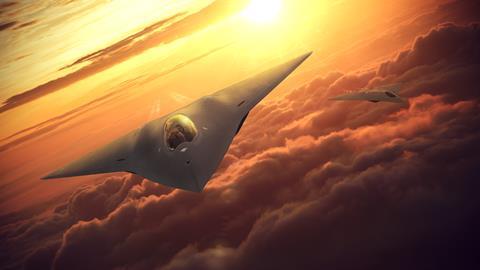The US Air Force (USAF) is officially accepting design proposals for the service’s sixth-generation fighter development initiative, known as Next-Generation Air Dominance (NGAD).

The much-anticipated announcement came on 18 May, when the USAF said it had released a classified solicitation to industry for an engineering and manufacturing design (EMD) contract for the secretive aircraft development effort.
“NGAD will include attributes such as enhanced lethality and the ability to survive, persist, interoperate, and adapt in the air domain, all within highly contested operational environments,” says air force secretary Frank Kendall, the service’s civilian administrator.
“No one does this better than the US Air Force,” he adds, “but we will lose that edge if we don’t move forward now.”
The intent of NGAD is to replace the fifth-generation Lockheed Martin F-22 air superiority fighter, which is operated only by the USAF. The service has 185 examples of the stealthy, ultra-manoeuvrable jet across its total force.
Despite being designed in the 1980s, the F-22 is still widely regarded as the most capable fighter on the planet. However, with rivals Russia and China designing their own fifth-generation platforms, Washington is eager to maintain its advantage in air dominance.
The USAF says it plans to select a primary manufacturer for NGAD and award the initial EMD contract by 2024. The announcement formally kicks off a competition that is expected to draw in all the major American aerospace giants, including Boeing, Lockheed and Northrop Grumman.
Kendall and the USAF appear enthusiastic about the innovation such a competition would spur, declaring the NGAD selection process will “maximise competition” with the goal of “drastically” reducing maintenance and sustainment costs in the final design.
“The NGAD acquisition strategy will invigorate and broaden the industrial base to deliver rapid and innovative war fighting capabilities,” the USAF says.
A separate, but related programme known as Next-Generation Adaptive Propulsion (NGAP) seeks to deliver a brand new engine to power the NGAD aircraft. The USAF in August 2022 announced contracts totalling nearly $5 billion to fund research and development of such a system.
GE Aerospace, Raytheon’s Pratt & Whitney, Boeing, Lockheed and Northrop were all awarded NGAP development contracts.
While attention will focus on the large original equipment manufacturers, NGAD business opportunities will not be limited to just the developers of clean-sheet design fighters.
USAF officials have previously described the NGAD concept as a “family of systems”, indicating their final selection for the aircraft will pair heavily with uncrewed, autonomous jets. These so-called collaborative combat aircraft (CCA) could handle everything from electronic warfare to carrying and launching additional lethal munitions.
Virginia-based Kratos, a relative newcomer to the defence industry, is an early leader in the CCA concept. The company is currently flight testing its low-observable XQ-58 Valkyrie autonomous combat jet, under contract with both the USAF and the US Navy (USN).
Chief executive Eric DeMarco recently told investors he is confident Kratos has a three-to-four-year lead on any competitors in the CCA space.
“Kratos is the only company with affordable, high-performance, American-made jet drones flying today,” DeMarco said on a 3 May earnings call. “We are focused on continuing to expand our first-to-market leadership position.”
Boeing is also developing a CCA in collaboration with the Royal Australian Air Force, which the company calls the MQ-28 Ghost Bat. The type represents the first combat aircraft to be designed and built in Australia in decades.
Separately, Boeing is testing a carrier-capable, autonomous aerial refuelling jet aircraft – the MQ-25 Stingray – for which the company is under contract with the USN.
The USAF specifically notes that CCAs will not be part of the NGAD source selection, meaning those contracts will be issued separately. Few specifics regarding design requirements are likely to be made public, owing to the highly sensitive nature of the sixth-generation development effort.
“Further information on the NGAD platform’s technical and programmatic details are classified to protect operational and technological advantages,” the USAF says.


























